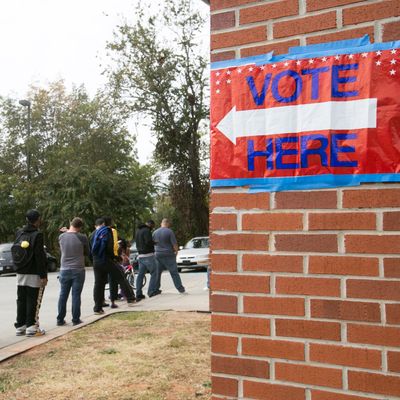
The first regular statewide primary election of this midterm year occurs today in Texas. And when the results pour in tonight, you’ll probably hear a lot about relatively high Democratic turnout, if early voting patterns (the Democratic early vote more than doubled since the last midterm in 2014) are any indication of what’s ahead.
There are several reasons for the focus on Democratic turnout in this primary. For one thing, it’s the one clear story line that’s likely to be available. Texas is a state that requires a majority vote for party nominations, so a lot of the competitive primaries won’t have winners tonight, but instead will produce finalists for a May 22 runoff. For another, Texas (like Georgia and Arizona) is widely perceived as a strongly Republican state whose demographics are slowly but surely driving it toward a more competitive posture. In 2016, Donald Trump’s margin of victory in the Lone Star State (9.2 percent) was lower than in Iowa (9.6 percent). The more optimistic Democrats see 2018 as a year when that great gettin’ up morning of parity with Republicans could arrive ahead of schedule. And finally, the buzz over the primaries reflects a reality that Texas has in common with other states around the country: an abundance of Democratic candidates, particularly in suburban congressional districts with vulnerable incumbents. More primary candidates tend to produce more primary votes.
The more difficult question is whether high levels of primary voters have any reliable predictive value for the general election. Data journalist Nate Cohn takes on that question today, and concludes that, well, it’s complicated, and may depend on the particular state or district, and most definitely on whether presidential primaries are involved. But in general, a primary surge is a good thing:
Nonpresidential primaries are relatively low-turnout affairs that provide a clue about which side’s base is more engaged. That’s extremely important in midterm elections.
Indeed, a regular primary surge is probably more significant than the kind of special election boosts in Democratic turnout we’ve seen in 2017 and 2018, where turnout is normally very low. And that’s particularly true if Democrats are suddenly attracting a lot of votes in areas normally dominated by Republicans, like upscale suburbs:
In Texas, Republicans are counting on the state’s G.O.P. tradition to insulate them from Mr. Trump’s unpopularity. That’s especially true in well-educated, suburban districts like Texas’ Seventh or 32nd District, where Mr. Trump lost but Republicans traditionally have a 2-to-1 edge in the primary vote. In theory, that kind of Republican tradition should be a meaningful drag on Democratic chances compared with the typical area where Mr. Trump was defeated.
Strong Democratic showing in a partisan primary in Texas would indicate that Republicans can’t count on vestigial partisan strength to insulate them from Mr. Trump’s distinct weakness among college-educated voters.
That’s another way of saying that Trump could be helping turn red areas blue. We won’t know for sure until November. Texas is a state with no registration by party, so the composition of the primary vote for either party can be fluid. But for suburban swing voters, the experience of voting for a Democratic candidate could be habit-forming, at least so long as the 45th president is in office. And along with energized Democratic partisans, they could form a powerful coalition, even in Texas.






























